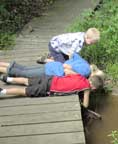 |
|||||
|
Volume 12, Issue 40 ~ September 30-October 6 2004
|
|||||
 Take a Hike Take a HikeTreat yourself and your family this fall to a walk in any of Chesapeake Country’s many lovely places. by Vivian I. Zumstein See the praying mantis?” 13-year-old Derek wants to know. I peer hard where Derek points. Sure enough, a praying mantis is camouflaged in a patch of grass on the gravel path. My other children crouch for a closer look. Seven-year-old Tommy bends his blonde head over the insect, studying it. It’s a funny-looking creature: huge, bright-green bulging eyes; thick, powerful forelimbs that appear held in prayer but are actually designed to grasp prey; a long, narrow body that blends in well with flower stems, leaves and grass. After freezing in place for a few moments, the praying mantis resumes its odd swinging gait across the path. Tommy rocks back and forth on his heels, imitating the insect’s rhythmic movements. We’re at Fort Washington, enjoying a family outing. It is a rare summer day that is not too hot or sticky, allowing us to venture on a walk, something we all enjoy. In addition to the praying mantis, my daughter, Emily, age nine, has counted seven different kinds of butterflies dancing on the breeze. We have seen osprey overhead and have wandered across a flower-strewn field of grass. But most summer days around the Bay do not inspire walks. The oppressive heat and humidity entice us to the pool instead. Fall: Now that’s the time to go outdoors. Fall Freedom A fall walk brings a sense of freedom to cave-dwellers who have cloistered themselves in air-conditioning all summer. Drops in temperature, humidity and the biting-bug population collaborate to make it delightful outside, helping us get reacquainted with nature. The forest becomes a special place in the fall, transformed by autumn colors. It’s not just all the vivid reds, oranges and yellows; the leaves, an amorphous mass of green all spring and summer, suddenly become individuals. Nature paints them all a bit differently so they stand out from their neighbors. Maples, the supermodels of the fall fashion show, display the full autumnal palette. A single maple leaf can be shot though with gold, scarlet, rust and still display a portion of striking green. Like snowflakes, no two are alike. The forest also sounds different in fall. Dry leaves still on trees rattle as the breeze passes through; those now fallen crackle under a hiker’s tread. Canada geese in their V-formation honk as they pass overhead. Walking brings you close to it all. It’s also wonderful exercise.  Fun and Fit Fun and Fit“Walking is an easy way to get cardiovascular exercise,” says Teresa diStefano Seifert of Owings, a professor of physical education at Prince George’s Community College. “Almost anyone can do it. It requires no special skills or equipment, and it puts very little stress on joints.” Anyone means any age. “Walking is an especially good family activity,” Seifert says. “Young and old can do it together. If you have an infant, you can put it in a stroller and still go. Also, instilling the importance of exercise at an early age is very important. Habits children learn young will carry over into adulthood.” Today’s kids need exercise more than ever. Over the past four decades the problem of childhood obesity has exploded. The Centers for Disease Control and Prevention reported in 2000 that 15 percent of American children between six and 19 were overweight. That’s almost nine million children and growing. Only four percent of children were overweight in 1960; the national percentage more than doubled between 1980 and 2000. Leading culprits are fast food and television. Many health organizations urge schools to offer one hour of physical education every day for all grade levels to help combat obesity. But parents know that most schools fall well short of that mark, so it’s up to them to make up the difference. Taking the kids on a walk is a great start. You don’t need to explain all the benefits of walking to children; this lesson is best taught by making a walk fun. Children are lightning-fast learners and naturally curious about their environment. Learning to recognize the different leaves and trees or taking note of local butterflies or birds gives them — and parents — a satisfying afternoon adventure. Where to go? Parks abound throughout Bay Country, charging nominal entrance fees if any, and they are seldom crowded. Get Ready Couch potatoes spoon fed on a diet of televised sound bites may resist when invited on a hike. Walking may seem dull and, worse, like exercise. “None of us spend much time outdoors any more,” says Tania Gale, a naturalist at Battle Creek Cypress Swamp Sanctuary. “Some kids whine about walking from the center here to the pond, which is only an eighth of a mile away. ‘It’s too hot.’ ‘There are too many bugs!’ they complain.” So it may take a little encouragement and support to get the family walking. "Treat a walk like you treat a long car ride with the kids,” advises Gale, who has led several youth hiking groups. “Plan ahead so the kids stay comfortable.” Staying comfortable means making sure all walkers have good footwear, bringing plenty of water and treats for the trail and letting the kids set the pace. Including friends also extends a kid’s comfort zone. With a friend, even a resistant hiker is less likely to get bored and less inclined to whine in front of a peer. A good hike starts at the walkers’ feet. “You don’t have to buy expensive boots for our area, but those water shoes or flip flops your kid wore all summer just aren’t right for a long walk,” says Gale. “Kids need good socks too, not cheap tube socks. A child with a blister will let you know about it.” Treats are the next step to comfort on the trail. “Keep the kids comfortable by making sure they don’t get hungry or thirsty,” Gale recommends. “Carry plenty of water, and pack treats.” Treat time, or energy breaks, not only keep the kids from getting hungry; they turn the walk into a special event. You can also use the lure of a treat to set short-term goals. When we get to the next stream, you might say, we’ll have an energy break. Hikes with a goal draw even reluctant walkers into the quest. Adults can enjoy a ramble along a trail through a forest just for being there. Children prefer a destination they can use as a marker of their success. Even better is an activity on the hike, for example, fossil hunting at Calvert Cliffs State Park or observing migratory birds at Patuxent River Park or Jug Bay Natural Area. The short legs and limited attention span of your youngest child should be the limiting factor of your outing. Plan to stop well before this child gets tired or cranky. If you aren’t sure how long your young walkers will endure, select parks that have a variety of interconnecting trails. Loop back at the first sign of impending grumpiness. Also, anticipate that you will have to provide the occasional piggyback ride to allow your youngest ones a break. The world looks different and wonderful from Daddy’s shoulders.  Savor the Moment Savor the MomentWhen you take the kids hiking, let them set the pace. This is not the time for a rigorous aerobic workout. Let the kids lead, and enjoy their discovery of things you might overlook at your faster adult pace. View a walk with the kids or grandkids as a well-deserved break from the frantic rush of adulthood and a moment to revisit the wonders of the childhood. While on the trail with kids, make your mantra life is a journey, not a destination.
|
|||||
|
© COPYRIGHT 2004 by New Bay Enterprises, Inc. All rights reserved. |

 The Bag of Tricks
The Bag of Tricks Tapping Imagination
Tapping Imagination